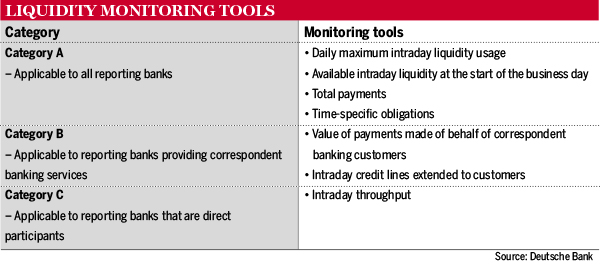One of the major cash management topics for 2015 concerns intraday liquidity management and in particular new intraday liquidity reporting requirements. The latter complements the Basel III regulations pertaining to the liquidity coverage ratio and the net stable funding ratio requiring banks to hold high-quality liquid assets in order to better safeguard themselves against external shocks and stress scenarios for a period of 30 days and one year, respectively.
Here, Christian Goerlach, global head of financial institutions balance sheet and liquidity at Deutsche Bank, outlines how the industry is progressing on this topic, what the regulators are ultimately trying to achieve, the complexities entailed for banks and how they are collaborating to ensure implementation gets introduced in the best interests of all parties involved.
The Banker: The Basel Committee on Banking Supervision [BCBS] stipulated in its recommendations that as of January 1, 2015, internationally active banks should report intraday liquidity information to their regulator on a monthly basis regardless of whether they are a direct or indirect participant in a clearing mechanism. Six months since that deadline has passed, is everything up and running?
Mr Goerlach: No, and there are a number of reasons why that has not yet materialised. First, the BCBS put forward 'recommendations' in its report. Not only are these open to interpretation, but it is the responsibility of each regulator to ensure they are passed into local law. While some regulators have issued guidance, many have yet to do so officially. It is expected that more regulators will initiate implementation throughout 2015. Until now, only a limited number of countries, including Switzerland and India, have formally initiated steps.
Second, the BCBS left the door open a little by allowing a phase-in by January 1, 2017, in cases of data availability constraints with correspondent banks.
TB: So in other words, very little progress has been made.
Mr Goerlach: No, that is not the case either. In fact, over the past six months we have witnessed a substantial amount of banking collaboration with key industry experts coming together and working collectively to actively move the industry forward on this subject. Six to eight months ago, nearly every article you read on the subject was negative, with critics pointing out that the industry was not only unprepared but faced numerous collective challenges primarily relating to interpretation, timelines and agreements on technical issues related to intraday liquidity reporting requirements. One of the major concerns was, and still is, that the recommendations from the BCBS will not be applied unilaterally across multiple jurisdictions.
TB: Can you expand on some of these collaborative efforts?
Mr Goerlach: At the 2014 Sibos conference in Boston, it became evident that the banks themselves would have to take more initiative on this topic. In November 2014, Deutsche Bank invited a number of large clearing banks to attend a peer group workshop to discuss technical as well as strategic challenges. That group now convenes on a regular basis under the umbrella of the Bankers Association for Finance and Trade, or BAFT, and is making good progress on advocacy (harmonisation of implementation, mitigation of unintended consequences and understanding on how collective data is used), implementation mapping, definitions for monitoring tools, and formats and data exchange. The technical and data formats topics aspects are addressed in a group formed under Swift. Both groups are fully aligned and have agreed to continue collaboration.
Two specific areas the BAFT working group has worked on have been the formulation of a common definitions glossary and the preparation of a position paper. The latter has been put together for discussion with regulators/stakeholders on the challenges and opportunities for the industry relative to both reporting and management for direct clearing and correspondent banking. This includes discussion on the risks posed, what is required for both management and reporting to be accomplished, and recommendations on each from a practical implementation standpoint. The paper also discusses the challenges posed through interaction with other regulatory regimes.
The positive news is that regulators across the globe are open to receiving the suggestions of the BAFT working group and engaging proactively in dialogue with the industry.
TB: How are the monitoring tools that are being implemented going to affect banks’ business?
Mr Goerlach: Seven monitoring tools have been developed, which are classified into three categories (see table). Additionally, the BCBS requires banks to consider impact under four stress scenarios, including bank’s own financial stress, counterparty stress, customer bank stress and market-wide or liquidity stress.
Essentially, the tools that are being implemented require a major rethinking for international banks with regards to how they monitor and manage intraday liquidity. Implementing tools will be particularly challenging for financial institutions utilising correspondent banking services. Indeed, correspondent banks will have to provide customers with timing information related to payments made and received throughout the day over settlement accounts. This marks a break with the practice we are used to today, which has been based on end-of-day.
This will not be an easy exercise for banks as it involves setting up new systems to consolidate internal as well as external data streams. Banks will also have to consider funding and collateral needs together with the utilised and available credit lines against daily payment flows. The complexity is increased from the perspective that an overview has to be maintained across jurisdictions, time zones and currencies. This is one reason why the collaborative efforts with regards to agreeing on data standards among banks is so important. More consistency means more efficiency and reducing what will be a very costly exercise.
Furthermore, banks will need to decide whether they want to engage in ‘intraday’ with a reporting-only approach or use the opportunity now and directly set up an intraday management of positions. In a recent survey Deutsche Bank run across financial institutions that use Deutsche Bank for cash management, almost exactly 50% of respondents indicated they are aiming for reporting in a first step and the other half indicated their plans to implement a real management framework from inception.
TB: You mentioned a Deutsche Bank survey regarding intraday liquidity. Can you share more on the background and the insights gained from the exercise?
Mr Goerlach: As one of the largest clearers in euros and US dollars, the two currencies that are likely to be most affected by intraday regulation, it is important for us as a provider to fully understand our client needs and therefore, in addition to the ongoing bilateral discussions with clients, we initiated a survey on intraday.
It was interesting to see that the thoughts are not only on reporting, but as already mentioned, a number of banks are planning to move into management right away. Furthermore, it is becoming evident that liquidity efficiency in payment processing will gain importance, for example, through an intelligent scheduling of non-timed payments according to patterns provided by the clients or by ‘following the sun’ depending on the time zone of the recipient. Another area of interest concerns the overdraft facilities and changes to be expected in this area.
It is a complex topic and a number of aspects have to be taken into consideration when planning the product upgrades and investments in this area.
TB: Overall it sounds like a lot has to be done and even more can be done – is this another cost topic for banks?
Mr Goerlach: The costs involved with intraday liquidity need to be weighed up against the potential benefits. The reporting requirements that banks will have to undertake should be seen as part of a wider exercise of having an effective intraday liquidity framework in place. Banks will gain a better understanding of intraday payment flows, have reduced intraday short balances and greater payment control, which in turn leads to smaller required liquidity buffers. An intraday liquidity model will also help achieve real-time conciliation of payments and receipts allowing for intraday alerts on credit lines.
That is the risk set-up required in an environment where timed payments are becoming more important (for example through the need to clear other asset classes centrally, as imposed by Dodd-Frank or European Market Infrastructure Regulation) and sensible for an industry that is moving to an immediate/instant payments set-up. It is also what ultimately regulators want to see from banks. Furthermore, it opens up new revenue sources for banks that have full control over flows, such as extended timed payment products and committed and/or collateralised intraday lines.
However, while bringing about the benefits mentioned, increased payment control or gain in visibility should not be used as a mechanism to delay payments. Such actions would exacerbate the market’s payment liquidity and result in completely the opposite of what regulators are trying to achieve. As such, strict protocols will need to be established on how and when to withhold and shared with regulators accordingly.







